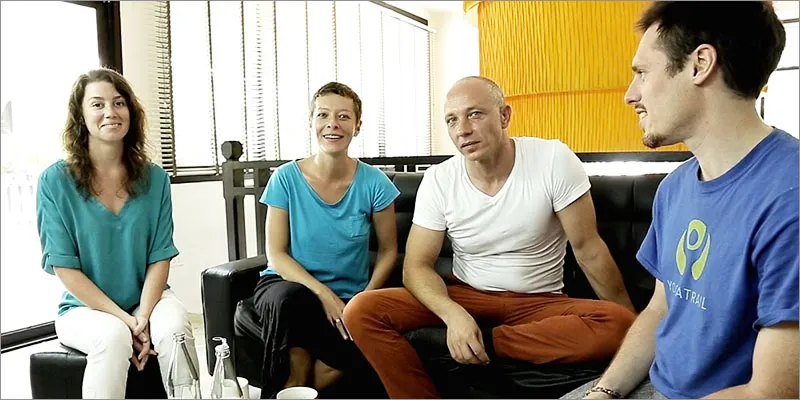Yoga and Money are oxymorons, but this European trio has made it profitable without ruining its essence
Today, from your American aunt trying to stay in shape, to the Prime Minister wanting to stay close to his roots, everyone has had their yearnings massaged by turning to yoga. A former-physicist-and-publisher couple hailing from Europe was travelling around the world when they stumbled upon a yoga teacher they instantly connected with, in the jungles of Kerala. But after spending a soulful week there, they found it increasingly difficult to stay in touch with that beautiful world even though yoga had become a rage across the globe.
Alex Jaton says, “We wanted to pursue it, but realized it is easier to find a hotel, a restaurant, a phone number, because there’s platforms for everything; but it was very difficult to find than a good yoga experience. You Google it, find an obscure place, only to discover that it was shut five years ago. I almost ended up quitting yoga because it was so difficult to find someone who you connected with, like you should with a yoga professional.” She was then at the heart of the publishing industry.

“In 2011, I was sitting in a class for web entrepreneurship, and we had to pitch a pretend business to pretend investors. The only glaring problem we really thought needed solving was curating a yoga experience, so we coined Yogatrail.com – filling that gap for our pretend consumers,” says her husband and former physicist, Alex Klein.
In the audience was Sven Earnst, their third co-founder, and to-be CTO, who had built websites for companies like BMW. He liked the idea, partnered with them the very next day and soon after, Yogatrail was set to be a reality.
“In the West in particular, people go to a yoga seminar or a class because they like a teacher. But these teachers, in most cases, are freelancers. As a yogi, it is tedious to keep up with the yoga world and chase your preferred guru; and as a professional, you don’t have tools to run your practice as a business and stay in touch with all your followers in an organised manner,” Klien says.
“In fact, professionals don’t even like to see themselves as a business. Money and yoga are an oxymoron. Yoga practitioners are skeptical of corporations and money-mindedness. So we have endeavoured to stay in their good books, by staying true to our cause of simply facilitating contact between yogis and teachers, albeit in our own creative way” he adds.
Yogatrail is like a social network for hardcore yogis, looking to stay abreast with yoga happenings from around the world. Users can create a profile in a simple four-step process that needs them to mention their designation – that is, whether they are a student or a teacher - their location, preferred yoga style and lastly, gurus/ yogis they admire. The website then leads you into a world where conversations about the best yoga practices and practitioners, events, seminars and courses are all waiting to be explored.
Alex Klein explains: “Earlier, yoga professionals would use Facebook to reach out to followers. You think you have a page, you post something, and all your fans would see and go crazy over the update. But in all the clutter nowadays, no one does. "We observed this problem in communication, and tried to bridge the gap by enabling yoga students to be connected to the yoga world on a specialised, niche platform, so they can see when and where their favorite yoga professionals are, what they are doing, what they are organising at their studios. Our platform in fact, is notification enabled. So, by customising your profile and spelling out your preferences, the website will ping you when it thinks something coming up might interest you.”
Yogatrail makes its money by selling premium memberships to yoga service offerings. “In India, there are centres like Hrishikesh or Mysore with teacher training schools to train yogis to become experts. They have people travelling there from far off places, to learn from the most erudite. Institutes like these, for example, opt for our freemium packages so we can promote their brand across the world, to bring the most passionate yogis in contact with the greatest gurus,” he adds.
So far, they have built a base of a 1,00,000 provider profiles, and close to 10 million yogis from around the world. With a million visitors per month, the website is expanding at the rate of 20 percent every month. Most of their user base comes from USA, at 50 percent, while 30 percent traffic comes from UK and Canada. Their ultimate goal is to be a marketplace where people can book classes and courses, upon which they will charge a small commission.
Adapting their services to Indian consumers
“In the last six months or so, we started thinking about India. We were keenly aware of its potential, but realised that yoga in India takes a much more puritan and organic form. Although we only have close to 2,000 Indian profiles, we know there are probably a million teachers and yogis out there, which is a number higher than anywhere else. Lately, we have noticed various clusters coming up on our website that are Indian, and we have been reaching out to them for our market research,” Klein says.

The trio realized classes are different here, where the one-on-one format is given importance over group sessions, where 30 to 40 yogis are crammed into a studio for generic exercises. “We are thinking of ways in which we can facilitate these one-on-one or semi-private sessions,” he says.
Another important observation is that India seems to be much more mobile-focussed. Unlike the rest of the world, India has almost skipped the ‘e’ phase and moved on to ‘m’ boom. Thus, building a mobile app was immediately added atop the checklist.
The game-changing alteration would be in the way they will propagate their app. As the app gets ready to go live by the end of the month, a major chunk of marketing shall take place through WhatsApp, which is undoubtedly the most ubiquitous medium of communication amongst Indians.
Why Yogatrail might be your one-stop solution:
“Most portals vet and rate all professionals through ratings on five stars, which is not what you can do with yoga. One person’s sweaty, intense five star rating could be the nightmarish zero of another who might be looking for a peaceful session that allows reflection,” Jaton explains.
Other competition they face is from local apps which may database the yoga world, albeit locally, within a single city. “But, according to us, a local platform for yoga is not adequate. You will find certain similar traits in people who like to travel, and the ones that turn to Yoga. It is not incorrect to infer that the traveller community gives yoga its largest patronage. For a community like that, a worldwide platform is definitely more convenient than finding a different app in every city they travel to.”
Besides, the essence of being on Yogatrail, is to stay truly connected. “We are not just a listing platform that must be used one time. Our users keep coming back to know what is happening, and how the yoga world is evolving. Our teachers and their loyal students are at the heart of our network.”







